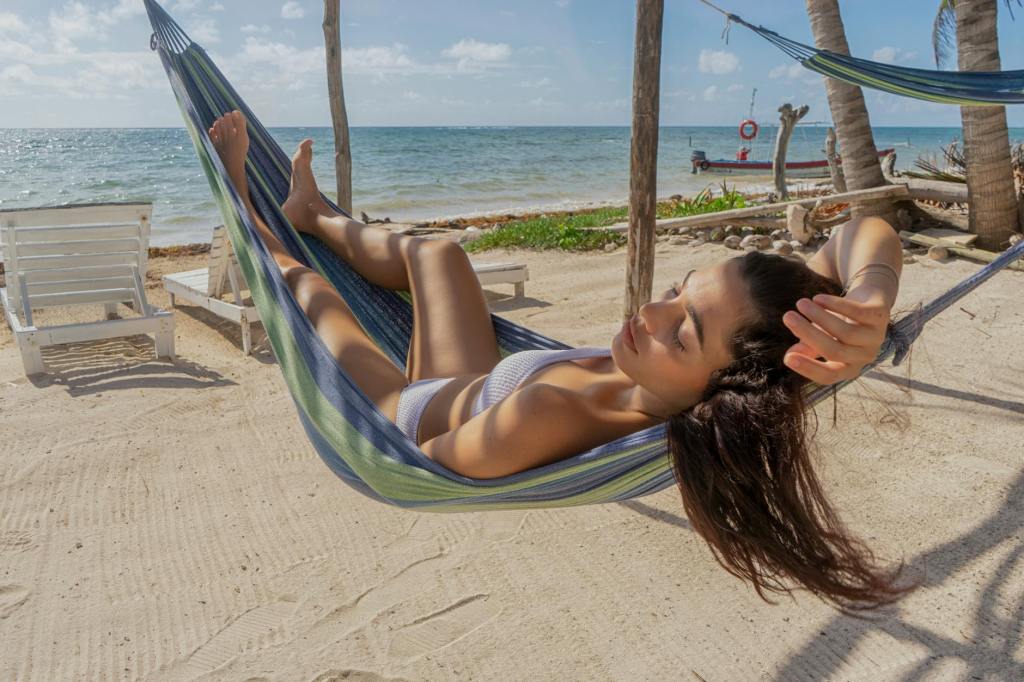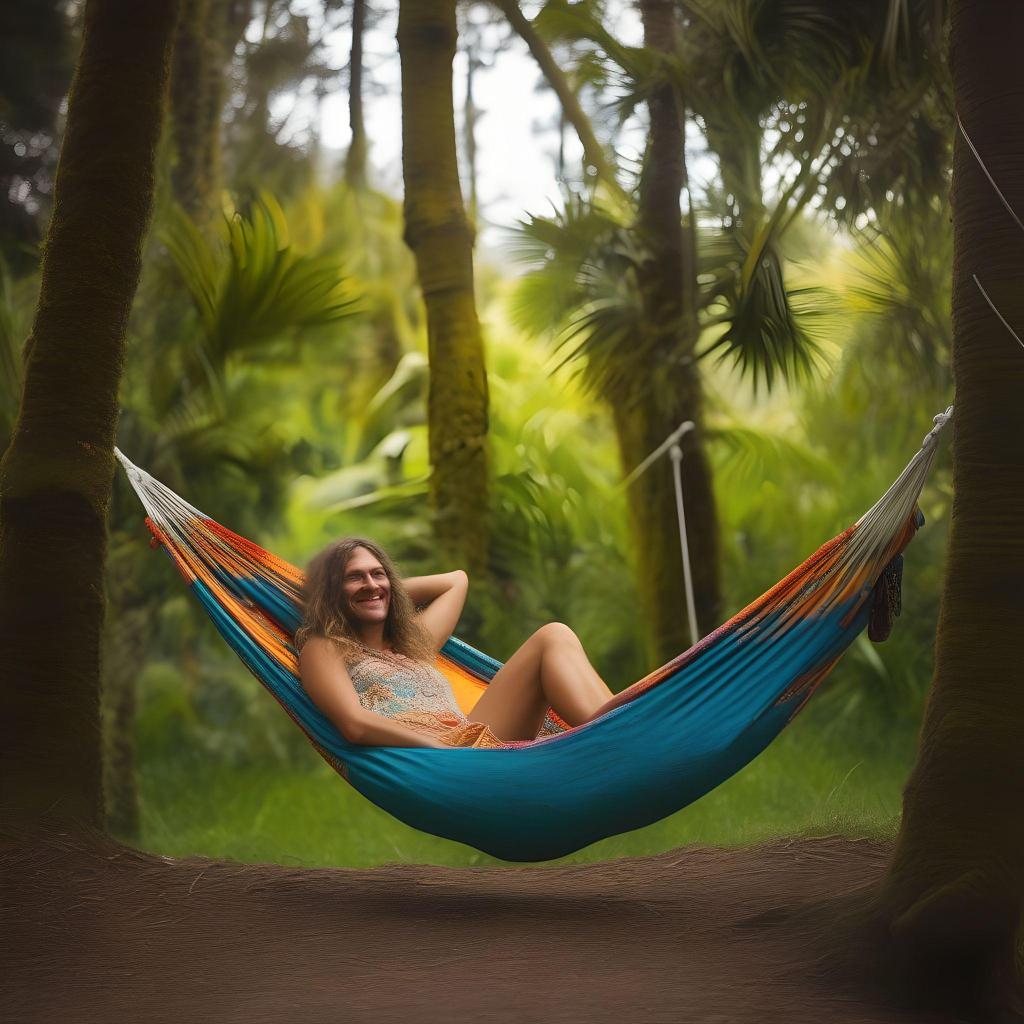Hammocks are a popular outdoor furniture item that can provide a relaxing and comfortable way to spend time outside. However, many people wonder how long they should spend in a hammock to get the most benefit from it. While there is no one-size-fits-all answer to this question, there are some general guidelines that can help individuals determine how long they should spend in a hammock.

One factor to consider when determining how long to spend in a hammock is the individual’s personal preferences and comfort level. Some people may find that they are able to relax and unwind in a hammock for hours at a time, while others may start to feel uncomfortable or restless after just a few minutes. Additionally, the weather and temperature can play a role in determining how long to spend in a hammock. On a hot summer day, for example, it may be more comfortable to spend shorter periods of time in a hammock to avoid overheating.
Another consideration is the purpose of the hammock. If the goal is to take a quick nap or read a book, a shorter period of time may be appropriate. However, if the goal is to spend an extended period of time relaxing and enjoying the outdoors, a longer period of time may be more appropriate. Ultimately, the amount of time spent in a hammock will depend on individual preferences and circumstances, but taking these factors into account can help individuals determine how long they should spend in a hammock to get the most benefit from it.
Choosing the Right Hammock

When it comes to choosing the right hammock, there are a few things to consider. The type of hammock, material and design considerations, and size and weight capacity are all important factors to keep in mind.
Types of Hammocks
There are several types of hammocks available on the market, including camping hammocks, backpacking hammocks, and backyard hammocks. Camping hammocks are lightweight and designed for portability, while backyard hammocks are typically larger and more comfortable. Backpacking hammocks are designed to be compact and lightweight, making them ideal for backpackers who need to save space and weight in their packs.
Material and Design Considerations
The material and design of a hammock can greatly impact its comfort and durability. Look for hammocks made from high-quality fabrics, such as ripstop nylon or polyester. These materials are lightweight, durable, and resistant to tearing and abrasion. The denier rating of the fabric can also be an important consideration, as higher denier fabrics are typically more durable.
When it comes to design, consider whether you want a single or double hammock. Single hammocks are ideal for solo travellers, while double hammocks can accommodate two people. Wider hammocks can also offer more comfort and versatility, allowing you to adjust your position and find the perfect spot for relaxation.
Size and Weight Capacity
When choosing a hammock, it’s important to consider its size and weight capacity. Hammocks come in a range of sizes, from single-person hammocks to larger double hammocks. Make sure to choose a hammock that is the right size for your needs, as a hammock that is too small can be uncomfortable and a hammock that is too large can be difficult to set up.
Weight capacity is also an important consideration, especially if you plan to use your hammock for camping or backpacking. Look for hammocks with a weight capacity that meets your needs, and be sure to compare different manufacturers and brands to find the right hammock for you. Popular brands like ENO, Warbonnet, Grand Trunk, and Hennessy Hammock offer a range of high-quality hammocks to choose from, so take your time to compare and find the perfect fit.
Setting Up Your Hammock
When it comes to setting up your hammock, there are a few things to consider to ensure you have a comfortable and safe experience. Here are some tips to help you get started:
Finding the Perfect Location
The first step in setting up your hammock is to find the perfect location. Look for two sturdy trees that are at least 10-12 feet apart. Make sure the area is free of any sharp objects or debris that could damage your hammock.
If you’re setting up your hammock at a campsite, check with the campsite staff to see if there are any restrictions on hammock camping. Some campsites may require you to use a tent or specific suspension system.
Hanging Techniques and Tips
Once you’ve found the perfect location, it’s time to hang your hammock. There are several techniques you can use to hang your hammock, but the most common method is to use rope or hammock straps.
To hang your hammock using rope, tie a knot around the tree trunk and then tie another knot around the hammock loop. Make sure to tie the knots tightly and test the hammock’s stability before getting in.
If you’re using hammock straps, wrap the straps around the tree trunk and then clip the hammock loops onto the straps. Make sure to adjust the height of the hammock to a 30-degree angle for maximum comfort.
Safety and Anchoring
Safety should always be a top priority when setting up your hammock. Make sure to use a suspension system that can support your weight and the weight of your gear.
If you’re camping in a hammock, consider using a sleeping pad or underquilt to keep you warm and comfortable. Make sure to anchor your hammock to a secure point, such as a tree or hammock stand.
Before getting in your hammock, check the loops and straps for any signs of wear or damage. Always follow the manufacturer’s instructions for proper setup and use.
With these tips in mind, you’ll be able to set up your hammock with ease and enjoy a relaxing, comfortable experience.
Accessories and Comfort
Enhancing Your Hammock Experience
To truly enjoy your hammock, it is important to have the right accessories. One of the most important accessories for hammock camping is a tarp. A tarp protects your hammock from rain, snow, and wind. It also provides shade during hot weather. A bug net is another important accessory that keeps insects away while you relax in your hammock. A sleeping pad or underquilt is also recommended for insulation and comfort.
Other accessories that can enhance your hammock experience include a top quilt, wall or rainfly, and a pillow. A top quilt is a lightweight blanket that can be used to keep you warm on cool nights. A wall or rainfly is a waterproof cover that protects you from rain and wind. A pillow provides extra comfort and support for your head and neck.
Protection Against the Elements
When selecting accessories for your hammock, it is important to consider the weather conditions. A rain tarp is essential for protecting your hammock from rain and wind. An underquilt or sleeping bag provides insulation and warmth during cold weather. A bug netting is also important to protect you from insects.
It is important to note that some accessories can add weight and bulk to your hammock setup. Therefore, it is important to consider the weight capacity of your hammock and select accessories that are lightweight and portable.
A rule of thumb for selecting accessories is to choose items that are compatible with your hammock and fit your budget. It is also important to select accessories that are appropriate for the type of camping you plan to do, whether it be minimalist overnight camping or a more luxurious relaxation experience.
In summary, selecting the right accessories can greatly enhance your hammock experience. It is important to consider the weather conditions, weight capacity, and compatibility with your hammock when selecting accessories.
Duration and Health Benefits
Optimal Time for Hammock Use
The duration of time spent in a hammock can vary depending on individual preferences and needs. However, experts recommend spending at least 20-30 minutes in a hammock to experience its full benefits. This is because it takes some time for the body to fully relax and adjust to the hammock’s position.
For those who are using a hammock for sleeping, it is recommended to spend at least 7-8 hours in it to ensure a good night’s rest. However, it is important to note that hammocks are not recommended for long-term use as they can cause discomfort and strain on the back and neck.
Physical and Mental Advantages
Hammocks offer a range of physical and mental health benefits. They can help reduce stress and anxiety by promoting relaxation and improving mood. Hammocks can also improve blood circulation and reduce pressure on the back and joints, making them an ideal choice for those with back pain.
In addition to these benefits, hammocks are also portable and easy to set up, making them a great option for camping, hiking, and other outdoor activities. They are also cost-effective and can be used in a variety of locations, including backyards, parks, and beaches.
It is important to choose a hammock that is comfortable and made from high-quality fabric to ensure maximum relaxation and support. Hammocks come in a range of sizes, so larger individuals may need to choose a hammock with a higher weight capacity to ensure safety and comfort.
Overall, spending time in a hammock can provide a range of health benefits and promote relaxation and well-being. Whether for sleeping or lounging, a hammock can be a great addition to any camping or outdoor adventure.
Frequently Asked Questions
What are the health implications of sleeping in a hammock every night?
Sleeping in a hammock has been shown to have several health benefits, including reducing back pain and improving sleep quality. However, if you have any pre-existing medical conditions, it is always advisable to consult with your doctor before making any changes to your sleeping arrangements.
Can side sleepers comfortably use hammocks for regular sleep?
Yes, side sleepers can comfortably use hammocks for regular sleep. However, it is important to choose a hammock that is wide enough to allow you to sleep on your side without feeling cramped. Additionally, it may take some time to adjust to sleeping in a hammock, so be patient and give yourself time to get used to it.
What is the ideal duration for a nap in a hammock?
The ideal duration for a nap in a hammock varies from person to person. Generally, a nap of 20-30 minutes is sufficient to help you feel refreshed and rejuvenated. However, if you have the time, taking a longer nap of 90 minutes can help you enter into a deeper stage of sleep and wake up feeling even more rested.
How does hammock length affect comfort and sleep quality?
The length of a hammock can have a significant impact on comfort and sleep quality. A hammock that is too short can cause you to feel cramped and uncomfortable, while a hammock that is too long can be difficult to get in and out of. It is important to choose a hammock that is the right length for your body size and sleeping preferences.
Is it advisable to replace a traditional bed with a hammock in the bedroom?
While sleeping in a hammock can have several health benefits, it is not advisable to replace a traditional bed with a hammock in the bedroom. Hammocks are designed for short-term use and may not provide the necessary support for long-term sleep. Additionally, some people may find it difficult to adjust to sleeping in a hammock on a regular basis.
What considerations should be taken into account for long-term hammock use while camping?
If you plan to use a hammock for long-term camping, there are several considerations to take into account. These include choosing a hammock that is durable and weather-resistant, ensuring that you have adequate insulation and protection from the elements, and setting up your hammock in a safe and secure location. Additionally, it is important to practice proper hammock etiquette and leave no trace when camping in the great outdoors.


Leave a comment